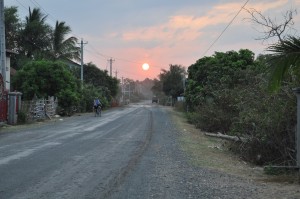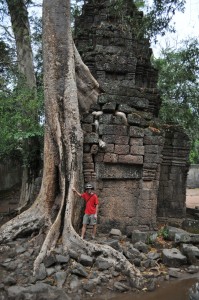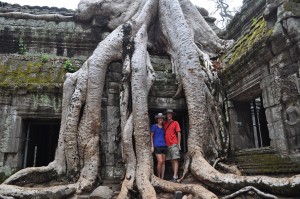Cambodia is the first country in Asia where we did zero camping. Several factors played into this decision–I had recently recovered from a rough stomach infection in Laos, so we thought rooms would be a little more comfortable. Of course the heat was a huge element as well, and by getting a room we were able fall asleep with at least the luxury of an electric fan blowing on us, keeping us from being completely drenched in sweat.
But here’s the wild card: Cambodia is one of the most heavily land-mined countries in the world. Minefields are often unmarked, meaning that straying off the road can actually pose a real threat.
Now, since we were on a primary road through this country, it’s unlikely that we’d have had much of an issue. But the landmine problem in Cambodia, a reminder of recent years of war and genocide, was only one of the things we learned about this country’s recent dark history. (If you’re interested in learning more about the land mine problem, I recommend this excellent article by National Geographic.)
We were a bit surprised to see how much further behind Cambodia seemed than the surrounding countries. We saw things that we might not have if we weren’t cycling, as the few tourist towns where we stopped seemed to be more developed and have more amenities. But as soon as we cycled away from our first city, we noticed the absence of refrigerators. Ice cold drink breaks have become part of our daily routine in the hotter climate, and instead of looking for refrigerators, we began looking for the bright orange coolers that sit outside small shacks. In Cambodia, an ice truck makes daily deliveries throughout the countryside to ensure people can keep drinks and certain foods cold at home. Watching the way this ice was often handled kept us motivated in avoiding drinks with ice in them!
This, along with many other things, was just one of the testaments to the toll taken on this country by the Khmer Rouge. The Khmer Rouge, led by Pol Pot, took power in Cambodia in 1975 and during their five-year regime, it is estimated that 2 million or more people (of the country’s 7 million) were killed or died of malnutrition, sickness and disease. The Khmer Rouge targeted the educated and intelligent… and thus Cambodia lost almost an entire generation of its upper class. So as we rode through Cambodia, we saw poverty and lack of development that spoke of this dark past.
We made two main tourist stops in Cambodia. First in Kratie, where we could go watch the Irrawaddy freshwater dolphins by sunset on the Mekong River. We very much enjoyed this outing–but forgot our camera! Sorry!
But our main stop in Cambodia–which is almost everyone’s main stop–was to Siem Reap to visit the ancient ruined city and temples of Angkor. We spent only one day traipsing around these historical sites–you could easily spend more.
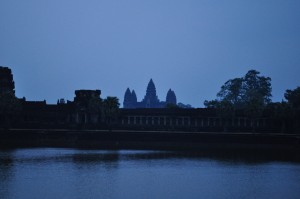
Sunrise at the main temple–Angkor Wat. It wasn’t actually much of a sunrise because it was very cloudy that morning. Angkor Wat is actually the world’s largest religious building.
Our favorite place was Ta Prohm, an ancient temple that was abandoned years ago… and nature ran its course. Trees have grown over crumbled walls and piles of rubble.
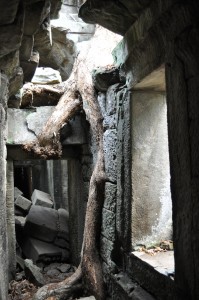
From inside the hallway… it was great because they literally let you walk around and explore the ruins freely!
Siem Reap is a thriving tourist hotspot, and we enjoyed splurging on a few Western treats like real ice cream and Mexican food. But even in this city, with all its luxuries, the reality of Cambodia’s past was reflected in the many beggars and street vendors who were missing hands or feet or entire limbs. Many carried around signs or flyers explaining what had happened to them. We bought from one vendor who sold books and paintings, even though he had lost both hands to a land mine years ago. It was encouraging to see him working hard and smiling, talking with tourists, despite the great loss he had suffered.
While Cambodia’s past is a sad one to be sure, we’ve been reminded that one of the values of traveling is the opportunity it affords you to learn about history in the places where it happened. We didn’t make it Phnom Penh to see the many killing fields and war sites, but we did buy a book (on Kindle) called First They Killed My Father. It’s the story of a girl who was 5 years old when the Khmer Rouge came to power, and the horrors she lived through during her childhood in Cambodia. If you’re interested in learning more about Cambodia’s history, we recommend it.

